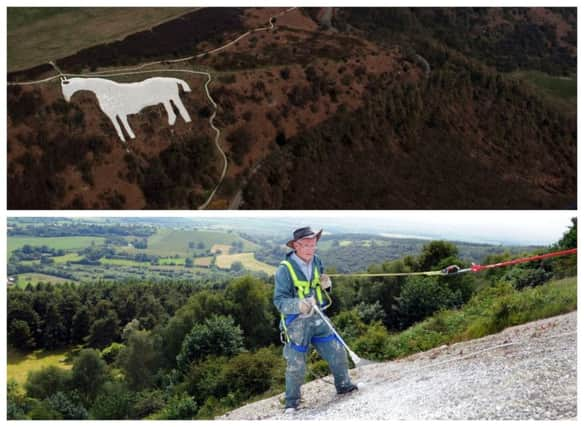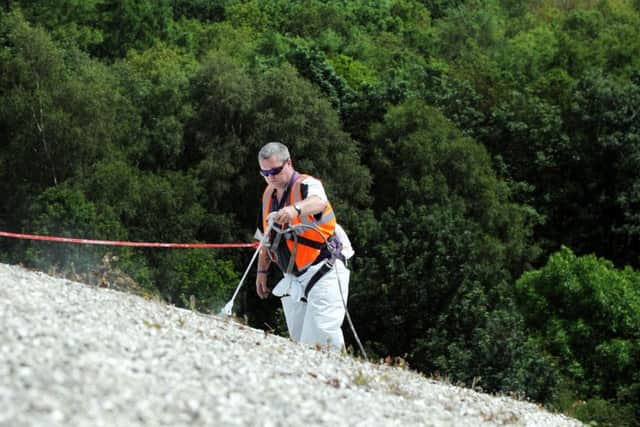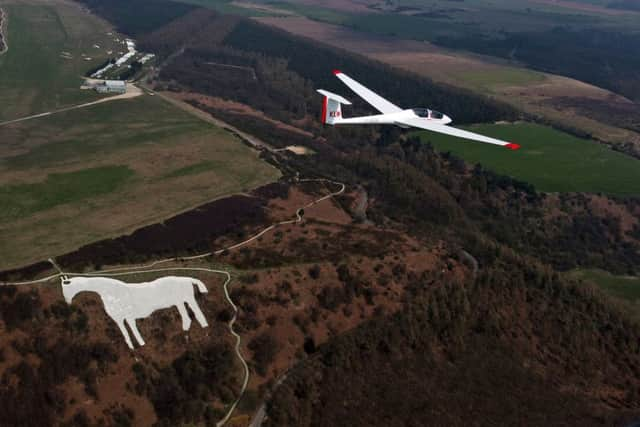Volunteers made to put Kilburn's horse on the hill out to grass


The White Horse carved into the Hambleton Hills in the North York Moors is one of the county’s most recognisable landmarks, especially since its exposure to the world by the aerial cameras following the annual cycle races.
It was created 161 years ago by a local schoolmaster and has been groomed ever since by a band of volunteers.
Advertisement
Hide AdAdvertisement
Hide AdBut the Kilburn White Horse Association, the charity that oversees its upkeep, has been told that health and safety considerations mean its members will no longer be allowed access.


The Forestry Commission, which owns the land on which the horse grazes, has said only its employees and contractors can now be used.
“It was an ultimatum really – we didn’t have any choice in the matter,” said Margaret Gomersall, the association’s treasurer.
“It’s all come as a bit of a shock and not very well received, I can tell you.”
Advertisement
Hide AdAdvertisement
Hide AdThe 19th century architects of the carving were helped by a small army of children in laying down the white limestone chips that form the shape.


But ironically, the association cannot now attract youngsters to carry on its work.
Ms Gomersall said: “For that reason, in some ways I can see it was inevitable that this was going to happen.”
John Roberts, secretary of the group, whose six active members are aged mostly in their 60s and 70s, said: “Had such health and safety regulations been in place in the 1850s the horse would not exist.
Advertisement
Hide AdAdvertisement
Hide Ad“It was laid out by local schoolchildren and cut by 30 local labourers. It couldn’t happen now.”


The Kilburn horse is said to have been fashioned after the similar carving at Uffington in Berkshire. But that one was etched into the area’s naturally white chalk. At Kilburn, a new coat on the pale limestone is necessary every few years – a job the association has taken on.
Ms Gomersall, who is 81, said the group would meet tonight to consider its future.
“The Forestry Commission has said we could still get involved in fundraising,” she said.
Advertisement
Hide AdAdvertisement
Hide Ad“But they’ve chosen to take the job on and I don’t want just to be knocking on doors asking for money.”


She added: “It might yet be a change for the best for the white horse, and that’s what we’re here for after all. How long the association will exist I’m not sure.”
Mr Roberts said: “The new regime will be good for the horse in many ways but very sad for the members of the association who have dedicated many years to maintaining the well-loved figure.”
The Forestry Commission said the slope on which the horse was carved was dangerous to navigate without specialist equipment.
Advertisement
Hide AdAdvertisement
Hide AdAlan Eves, its forest management director for Yorkshire, said it had been talking to the volunteers for some time.
He said: “We are grateful for all the hard work that has been carried out for so long by the White Horse Association volunteers to maintain the white horse and ensure its survival. We have been talking with them for a while and we both recognise that times have moved on and agree that the work on the steep slope is dangerous unless you have specialist equipment and appropriate training.
“We must keep the White Horse Association volunteers and the thousands of other volunteers who choose to support our work across the nation’s forests just as safe as our own staff. As a result we have agreed to maintain the white horse at Kilburn ourselves.”
The horse is the most northerly turf-cut figure in Britain. At 314ft long and 228ft high, it is best viewed from a distance, although steps down the side afford a closer look.
Advertisement
Hide AdAdvertisement
Hide AdFour years ago, the Association used 220 gallons of masonry paint to retouch the carving, with contractors secured by ropes on the hillside.
The horse fell into disrepair after the First World War. It was renewed in 1925 following a public campaign which is commemorated by a memorial in the nearby car park.
The website of the North York Moors National Park makes a point of noting the volunteers’ role in maintaining it. “It’s limestone, not chalk, under the horse but if it looks grey, don’t worry – the white horse is regularly ‘groomed’ by the Kilburn White Horse Association,” it says.